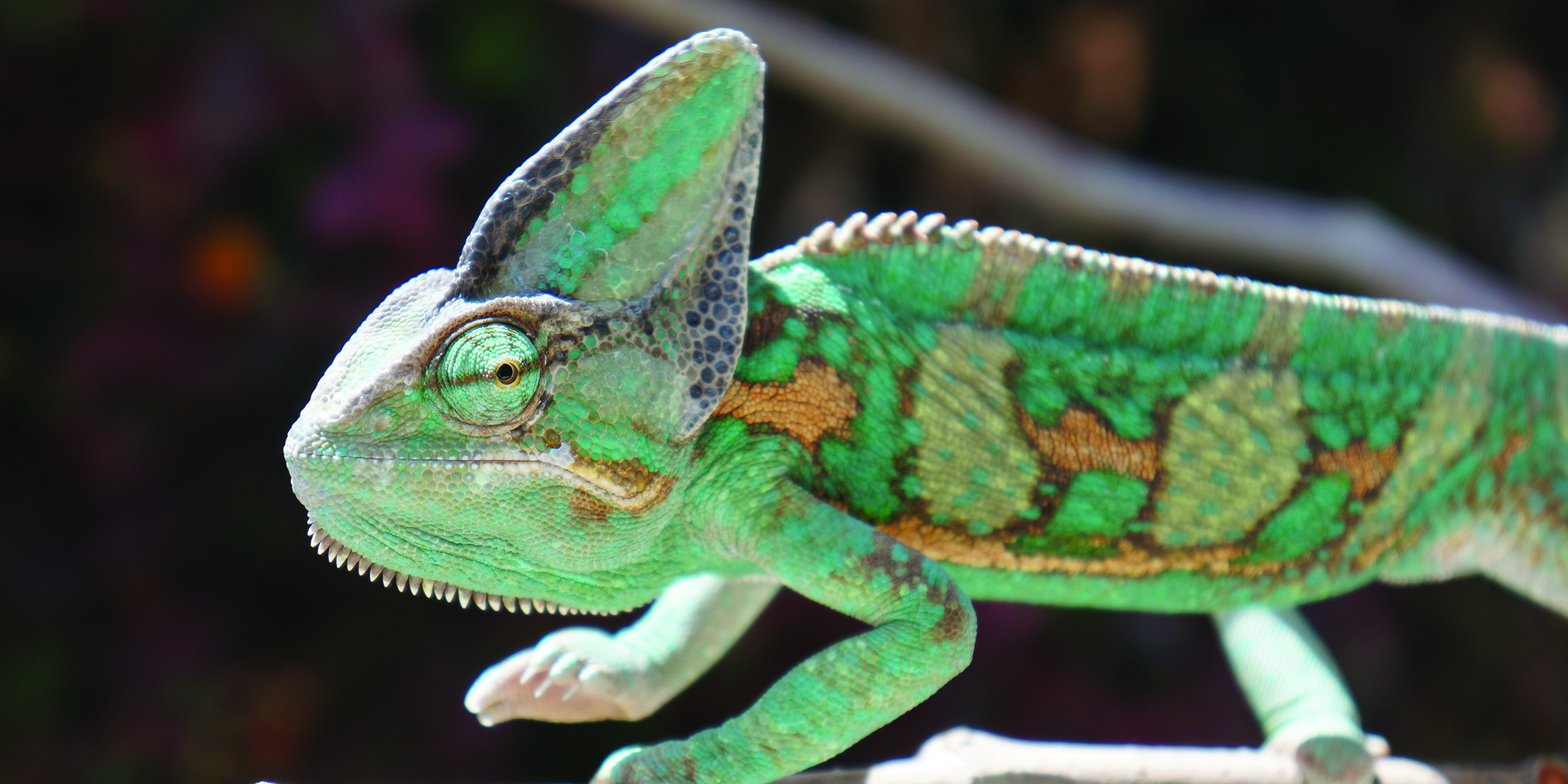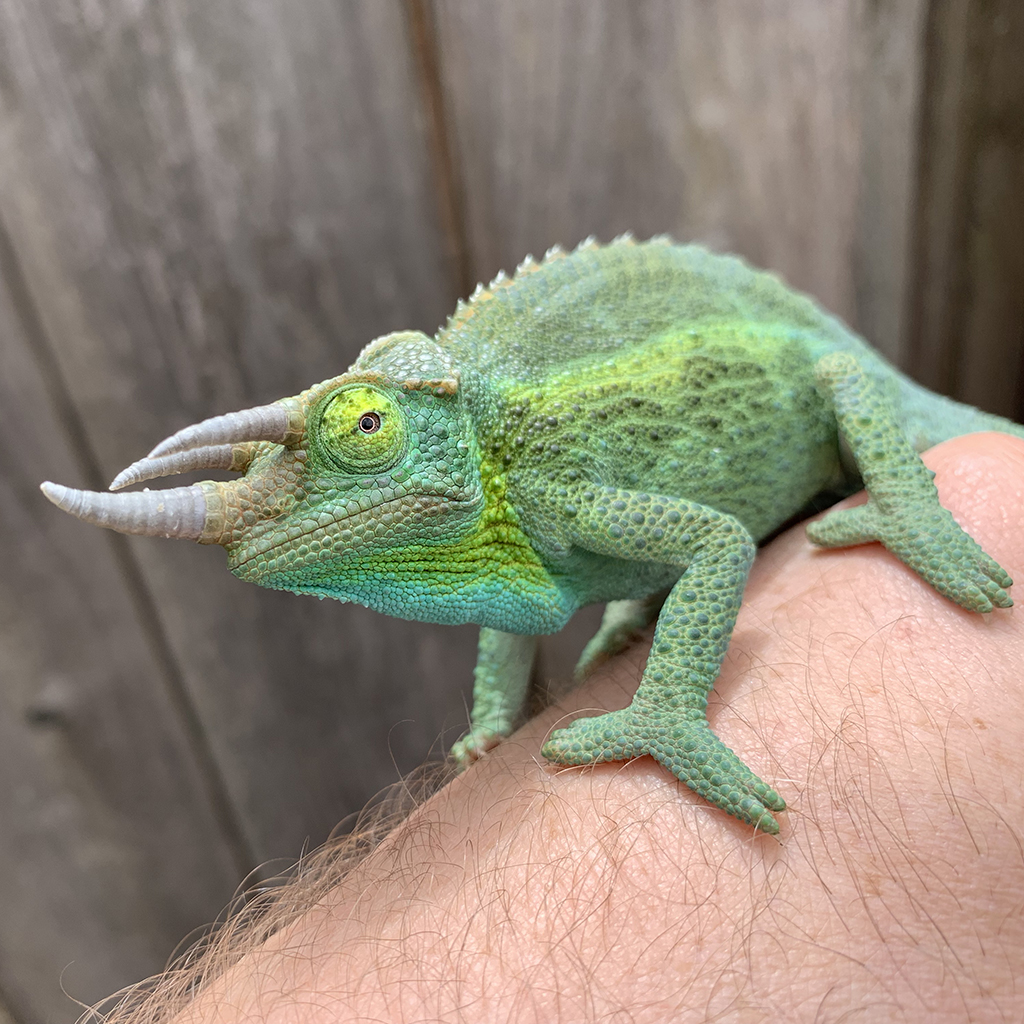Summary: Heating Your Chameleon
- Chameleons use the sun to warm up in the morning
- Common chameleons thrive in room temperature (mid 70s) once warmed up
- Basking bulb is usually an incandescent bulb in a reflector
- Basking bulb can be put on timer to only come on in morning
- Beware of burns
Why heat is important

Chameleons are ectothermic, or “cold-blooded”, meaning that they do not produce their own heat. Their body is designed to rise and fall with the outside temperature. But they still need to be within certain temperature ranges for their body to properly function so they will move to find sun and then retreat to the leaves be protected from the sun. We need to replicate this in our captive husbandry. Through the use of a basking light we simulate the sun. Through the use of dense plant cover we simulate the shade. And thus we let the chameleon decide what they need to get to the proper temperature.
Each chameleon species will have different temperature requirements and it is critical that you understand what is needed by each species. It is even important to provide a cool down at night for a number of species. We think of anything that looks exotic as having come from a steamy Tarzan jungle. While tropical chameleons do exist, an enormous number of species come from high elevations where they need mild temperatures and a significant night time drop in temperature. The infamous Jackson’s Chameleon “sudden death syndrome” where they suddenly drop dead has an unknown cause, but a likely scenario is physical exhaustion. Without the nighttime drops, their body does not get the sleep it needs. The body slowly exhausts itself and then just gives out. We are still investigating this particular situation, but giving your chameleon both the heat – and cold – that it has developed to require is part of the recipe for success.
What heat is needed by chameleons during day and night
Each chameleon will require different temperatures, but the pattern is the same. They warm up in the morning up to a comfortable temperature and then hide away from the sun to maintain that temperature. When night time comes the temperatures drop. It is up to you to know the temperature ranges for your chameleon species and provide those.
This is where knowing the elevation and geographic location for your chameleon species is important. The closer to the equator and the sea level the species lives the less temperature extremes between night and day they receive. So a Meller’s Chameleon which lives between 0 and 800 meters elevation and in Tanzania, close to the equator, would want a minor variation in day/night temperature, while the Jackson’s Chameleon which lives on the equator, but up to 3200m in elevation, will decline in health towards death if not given around a 15F drop at night. There are so many variables and microclimates that each chameleon adapts to that we have to be researchers for our chameleon species.
As a simple guide for the most common chameleon species, for panther chameleons you can consider heating if the environment consistently gets below 55F at night. For a Veiled or Jackson’s Chameleon consider night time heat if your temperature consistently get into the 40sF at night. That said, I have kept both Jackson’s and Veiled Chameleons outdoors where it got into the high 30sF and Panthers down to 50F and they remained healthy. I am not encouraging these extremes. I only wish to demonstrate that chameleons have a much greater tolerance towards lower temperatures than we have explored. This is a characteristic of being ectothermic (cold blooded).
If your home gets too cold at night for your species, then the preferred approach is to heat the room rather than the individual terrarium. Localized heat can easily become too much. The larger the space you are heating the easier it is to ensure it does not get too hot. If you do need to do localized heating, a glass terrarium and a thermostat will provide insulation and feedback to make sure the heat does not become overwhelming.
Some homes in high altitudes or northern latitudes may have to make accommodations, but the majority of urban dwellers will not have to provide any heat at night beyond what you are doing for human comfort.
Artificial sources of heat
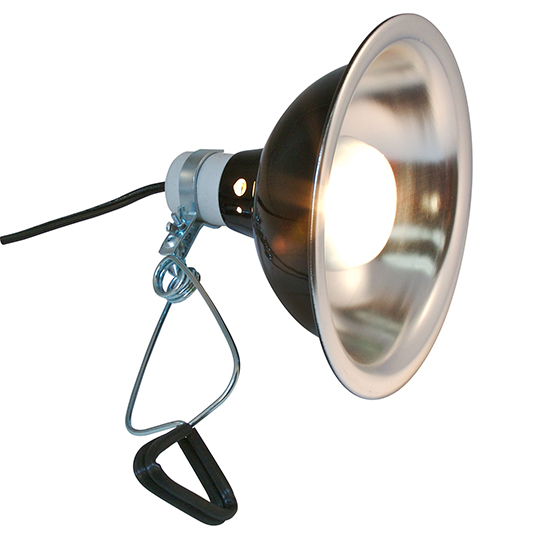
The most common source of heat used in chameleon husbandry is an incandescent light bulb. This technology produces light by heating a filament. This process is not very efficient and much energy is given off as heat. Ironically, that inefficiency expressed as “waste” heat is exactly what we need! Thus we have a challenge as our engineers find more and more efficient form of lighting. The more efficient they are the more light and the less heat! With the advent of LED lighting we are actually having a much harder time finding cheap heat producing lamps. Even the discount stores are carrying predominantly LED lights! Although we are coming to the end of the days we can get cheap incandescent light bulbs at every home improvement or even grocery store, the major reptile product suppliers are producing full product lines of basking lamps from 25W to 150W.
Non-lighting heat sources

There are non-light emitting heat sources such as Ceramic Heat Emitters, heat tape, and heat panels. These can be used to offer localized heat. But if you have a room for your chameleon where you can shut the door, a space heater can produce a non-focused heat which will produce a small gradient.
Because chameleons are, generally, comfortable with the nighttime temperatures that we maintain in our human homes there has not been much done to develop non-lighting heating methods in our community. But if you are in a situation where this is important then it is time to consider your gradients. Localized heat emitting sources need to be used carefully because they produce certain amounts of heat which then dissipates with distance. The more localized the heat source the greater your gradient in a smaller distance. This means that with a ceramic heat emitter inside a cage, the heat has a noticeable change in temperature within a couple inches. On the other side of the spectrum, a space heater hearing the room will produce a uniform temperature level. Which method is best for your particular situation is a judgement call on your part.
Heat lamp strength

Your basking bulbs will be measured in watts with common strengths being between 60 and 150 Watts. The trick is to figure out what strength to use and how to mount it. The closer you mount the lamp the tighter the heat beam will be, but the lower the wattage necessary to get a good basking spot. The further away you mount the lamp, the wider the area it warms and the higher the wattage necessary to get a certain temperature. Most people end up resting the basking lamp on the screen top of the cage. But if you are able to mount the lamp securely higher up you reduce the chance of burns dramatically. The reason is in the heat gradient coming from the bulb. Close to the bulb, the difference between one inch left and one inch right can be significant. But with a higher wattage bulb mounted further away there is more space that is the same temperature. This means that the chameleon can fit his entire body in the same heat area. This reduces the risk of him angling himself in a way that produces burns.
The best way I have found to measure when the heat is enough is to use the back of your hand to ensure that the heat is warm, but not uncomfortable. We tend to use temperature guns and thermometers to dial in the exact heat level, but this is not necessary. You have been outside and know what it feels like to have sun on your hand at 9:30AM. That is what you want it to feel like. If your chameleon’s home country is getting into the 80s then go out on a day where it is getting into the 80s in your home town and feel how the sun feels on your hand in the late morning. This is what you want it to feel like three inches above your basking bulb. The problem with relying on a temperature measurement device is that you have to take into account how and where you are measuring with a high risk of measuring a different temperature than your chameleon will find. The back-of-the-hand method gets you personally involved and gives you the best judgement.
Positioning your heat lamp
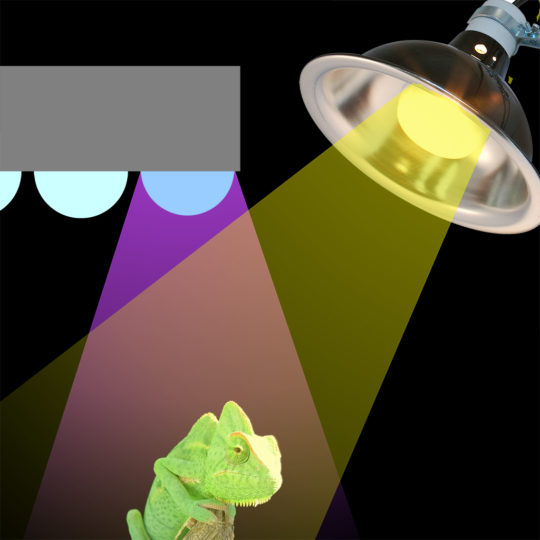
Your ideal situation is where the basking lamp is heating the perching spot where the highest level of UVB is. This caters to your chameleons natural condition where light = heat = UVB. If you are just placing the basking bulb on the top screen then your options to do this are limited. If you have a post or some method of mounting the basking bulb above the cage then your flexibility increases. Breeders have reported that chameleons can detect UVB and will bask under heat and then UVB so it appears our efforts to have UVB and heat together may not be necessary. I continue to experiment with both set-ups to determine if there is any difference. So, bottom line, it is your decision.
On a final note, be aware of how far your misters reach. You do not want your light bulbs to be hit with cold water from the misters or any other water source. Electricity and water do not mix with positive results and a hot bulb sprayed with water may shatter.
How long should the heat lamp be on?
Once the chameleon is in their cage you can then watch for behavior clues as to how long to leave the heat lamp on. If you have a screen cage you may be able to leave the lamp on all day, though it is really just wasting energy if your chameleon is not using it. In a solid side enclosure with low ventilation you must carefully monitor for dangers of over heating. Watch your chameleon’s behavior. The ideal behavior is that the chameleon goes to the basking light, basks for a time and then retreats back into the leaves. If there is a pattern to how long he stays under the light then you can leave the light on for 15 minutes beyond his maximum basking time and it can remain off for the rest of the day. If your chameleon is still underneath the light when it goes off then the basking time needs to be extended. Just keeping the light on all the daylight hours is an option if the ambient temperature is not getting beyond the comfortable level temperature for your chameleon. Since they are chameleons, we can tell if they are cold by whether they wear their resting colors during the day or if they stay dark trying to soak up as much energy as possible. The dark colors indicate the need for more heat or longer heating sessions.
Warnings! Burns!

Chameleons are not used to their light being so hot that it can burn them. They obviously feel heat so they know how long to bask, but they do not seem to feel the pain of their casques and back spines burning. Chameleons are not used to burns. They don’t seem to feel it happening or else their brain puts a higher priority on warming up than responding to that pain. The end result are wounds that can create infection and leave ugly gray scarring. This is mostly from the practice of using focused basking bulbs resting on the top of the cage. The localized heat is too intense. The solution is to use a higher wattage bulb mounted further away and creating a more uniform heating experience for your chameleon.
Cooling your cage
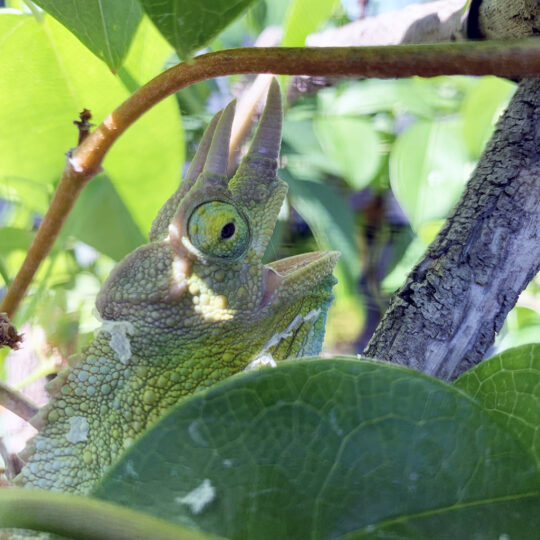
Cooling a cage is much more difficult than heating a cage. If your ambient room temperatures are higher than your chameleon’s comfort level then action must be taken. This is most commonly an issue with nighttime temperatures for Jackson’s Chameleons. Fans can be set-up to create air flow. And in emergencies a bag of ice placed somewhere near where the cold with radiate, but not so near that it will freeze the chameleon is an option. The best method of cooling is to cool the room with an air conditioner. When I was moving on a regular basis, I had a couple of portable AC units which I would put in the chameleon room. Be aware that an air conditioner will dry the air and so increased humidity measures must be put in place.
Navigation
This seminar is part of the introductory course Chameleon Basics which, in turn, is a module within the even larger Term 1: Getting Started With Chameleons.

